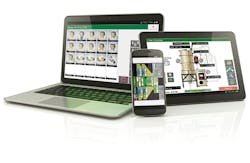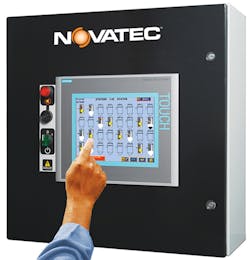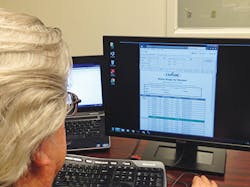Special Report: Web-enabled controls have powerful impact on entire production facility
Control technology plays an increasingly prominent role in both the quality of plastics products and the productivity of the facilities that make them. The control technology for today's materials-handling equipment and systems — make that networks — is one of the most notable examples. These control systems are integrating the different technologies collectively known as materials handling to provide functionality unheard of as recently as five years ago.
Among the advances are blenders that record precisely how much material — with component subtotals — enters the process. If the control system puts that in a database, it can be compared with the amount of product shipped — an instant look at production efficiency. But it takes a control system network to even make the raw data available. The good news is materials-handling controls are already doing that and firms are developing advanced technologies that will further empower the processor — not someday, but very soon.
Web-enabling boosts big and small
materials-control systems
Conair Group, Cranberry Township, Pa., offers two primary control systems for its materials-handling products: one for small systems and one for large ones. Bob Criswell, Conair's manager of mechanical engineering, is quick to point out that they are Web-enabled. When he describes how that empowers the user, you immediately understand why the feature is top of his list.
Conair's FLX system was developed specifically for plastics processors that need a simple, entry-level materials-handling system that can be expanded as necessary. The system uses a combination of centralized Input/Output (I/O) and distributed I/O expansion modules, interconnected via industrial Ethernet to provide control of up to 128 receivers, 40 pumps (plus two back-up pumps) and 256 source valves.
For larger systems, Conair designed its ELS (Ethernet Loading System), a fully distributed control system using Allen-Bradley components that are interconnected via an industrial Ethernet. It can control up to 500 receivers, 96 pumps and over 1,000 sources.
Criswell says FLX became Conair's first application for Web-enabled controls when the technology was first implemented in 2011. Since then, the company has added the Web-enabling feature to other products, such as ELS, TrueBlend blenders, TrueWeigh gravimetric continuous blenders, Conair's extrusion-line controls and TrueFeed gravimetric feeders. It is also available on Conair DC-T dryers and drying monitors.
The reason the technology is so prominent, says Criswell, is simple: With Conair's Web-connected equipment, key people never need to worry about being out of touch. If there is an alarm on any Web-enabled equipment, the controls send an alert via email or text message. Users can log in from almost anywhere to assess the situation and, if necessary, make changes immediately.
Using any standard Internet browser, any computer, tablet or smartphone can display the same control interface that appears on the control panel in the facility. Even better, anything that can be done at the control panel itself can be done remotely. How remotely? From the other side of the plant, the other side of town or the other side of the world. Controls within the system that have data-gathering capability, like the SB-2 controls on TrueBlend blenders, can generate reports that can be immediately exported to facilitate process validation.
Criswell provides a real-world example. Samtec USA, New Albany, Ind., a $613 million manufacturer of electronic connectors and cable systems, has used Conair Web-enabled controls to save time and increase worker efficiency since 2013. Its system links 15 hopper loaders on molding machines, plus four blenders, one deduster and loaders on 11 dryers to a Conair FLX central control station that links wirelessly to the Internet. As a result, one employee can attend to all of the loaders, blenders, etc., without needing to run over to the machine or to the FLX control station, which could be 200 feet away. From anywhere in the plant, that person can turn any piece of equipment on or off, see any of the control screens and change any setting on them. It's also useful for troubleshooting.
As noted previously, equipment with Web-enabled controls and data-reporting capability can readily export information to the cloud. In addition, Conair gravimetric blender products can use the Microsoft SQL server relational database management system that's widely used in general business applications, to track how much resin, regrind, additives and color are being processed.
Criswell says materials-use reporting software has been available with Conair blenders for years, but the use always was limited to generating reports on what a specific blender was doing over a given time. However, in the new SQL server-based system, all data generated by all blenders goes into the same database. A well-written query can mine that data to help processors operate more efficiently and more profitably.
Each TrueBlend SB-2 touch-panel control (Version 1.08.0 and newer) has the ability to communicate directly with a computer hard drive using SQL server software and a standard Ethernet network. When the control first connects with the new database in the SQL server, it will create all of the required data tables and data relationships. Then, as the blender operates, it will periodically and automatically add data to the tables in the database. How often the data is written to the server is programmable.
Control system design and features
multiply efficiency
Making a materials-handling system that precisely fits its owner now and, more importantly, in the future is vitally important to materials-handling equipment and systems supplier Novatec Inc., Baltimore. "We consider that central system controls will have an impact on the operation of the entire plant," says Jim Zinski, product manager of conveying and controls at Novatec. And that starts with the basics: the design of the control system and what it's made of.
He says the company prefers to use proven programmable logic controller (PLC) and human-machine interface (HMI) technologies, both for their reliability and the availability of off-the-shelf components. Also important, they provide open communications protocols, and that makes them easier to integrate with other control and computer systems in the processor's facility. Novatec always provides a flexible architecture so a processor can buy what's needed now and later buy what it needs to expand and modify the system painlessly. Novatec offers choices of control network types and is coming out with more soon.
Zinski says, "Novatec was a leader in the now-popular remote I/O expansion approach, where you buy a main panel and it controls a certain number of pumps, stations, valves or whatever. When you need to go beyond that number, you simply add remote I/O panels near the additional devices and connect them. Run an Ethernet cable from the remote panel back to the main panel where the PLC is and you've established communication. You've minimized your wiring cost and simplified future expansions. For a new system, initially we would offer a five-pump, 16-station main panel or five-pump, 32-station panel to start. We'd include 10 purge valves with the 16-[station] panel and 25 with the 32-[station] panel. We know they will be used, and we don't want everything to be an option."
The control is capable of handling up to 20 pumps and 128 stations. Zinski says Novatec has gone larger, even to plants pushing 200 stations, "At that point, the processor has to determine whether it wants one control running the whole facility or dividing it into discrete areas with controls that talk to one another and let them see their entire operation without being tied to one control. To make it easier, we have remote HMIs, a panel with a touch screen and no intelligence inside. Connect that HMI to the main panel with an Ethernet cable and you can run the entire control from either location. Up to four of those can go in, along with a main panel."
Processors typically choose to consolidate materials handling in a central area that can be in the main plant or near shipping/receiving. Surge bins for materials, drying hoppers, central blenders and dryers and more will be in that area and a couple of trained operators can maintain it all. That would be where the main panel/PLC goes because so many devices are right there. Remote HMIs can go wherever the processor wants operator access. They are Siemens HMI Comfort Panel units with 7- or 12-inch high-definition, color touch screens, and both sizes display all functions.
Zinski says, "So the controls will be easy to use, we emulate a familiar format like Windows and have Office-type functionality like copy-and-paste. That may not sound innovative, but it's familiar. There could be 10 or more pumps and 100 stations needing setup, and each station could have up to a dozen settings. Copying and pasting a setup can save a lot of time and eliminate errors." Setups can also be saved for later use, for example, when a component is replaced. Stations and pumps can be given names operators can remember easily.
Zinski says Novatec will introduce a Profinet-based distributed I/O system with a main touch-screen panel with PLC, from which Ethernet cable will connect stations and pumps in a daisy chain around the factory. Each node on that network will have I/O, so it will be considered distributed I/O. There's a tradeoff, says Zinski. Upfront hardware investment for a distributed I/O system costs more but is easier to install, typically plug-and-play. It doesn't take a lot of expertise to install and it's easy to expand.
He says there are distributed control products that have a small controller on each station and pump. Maguire Products Inc., Aston, Pa., is coming out with that type of control and Novatec also will market it. Zinski thinks for smaller systems it may be attractive because initial cost for a few stations will be lower, the interface is good and expansion is easy. But as systems get larger, the cost penalty for a controller at each station may be too much, and Novatec's current system will be a better choice.
Besides system architecture, Zinski says Novatec puts convenience and safety features into its FlexXpand FX2 control. It can be accessed via Web browser on any computer or by a networked smartphone or tablet using a virtual networking app; actual screens are displayed and are functional. The pump back-up feature allows one-touch activation of a back-up pump to take over for a pump going offline for maintenance. The optional Auto ID proofing of material source-destination connections is process protection, as is the optional pre-dry confirmation that keeps material from coming out of a drying hopper too soon. Another option is a variable frequency drive and speed-control package that lets an operator choose among standard, low or high conveying air speeds depending on the material and system conditions. Local or low-consumption materials can go through a smaller-diameter tube as well.
Novatec says its materials-handling controls also provide an affordable portal to other Novatec equipment. Dryer status can be seen and dryers remotely controlled, including central dryers with multiple hoppers. A user can see the status of downstream extrusion products and remotely control the equipment. The status of up to 12 blenders can be seen and they can be accessed individually to see alarms, totalizers and component operation. Recipes can be pulled from the recipe library and loaded to a blender, or one can be pulled from a blender and stored in the library. The system will monitor rail car unloaders and silo levels by accessing data from ultrasonic or 3-D sonar sensors at the silo, and weight can be monitored from load cells.
Zinski says the controls side of the entire plastics industry is ever-changing. "The technology isn't about to stop and it will keep bringing out new capabilities."
Rob Neilley, senior correspondent
Contact:
Conair Group, 724-584-5500, www.conairgroup.com
Novatec Inc., 410-789-4811, www.novatec.com



